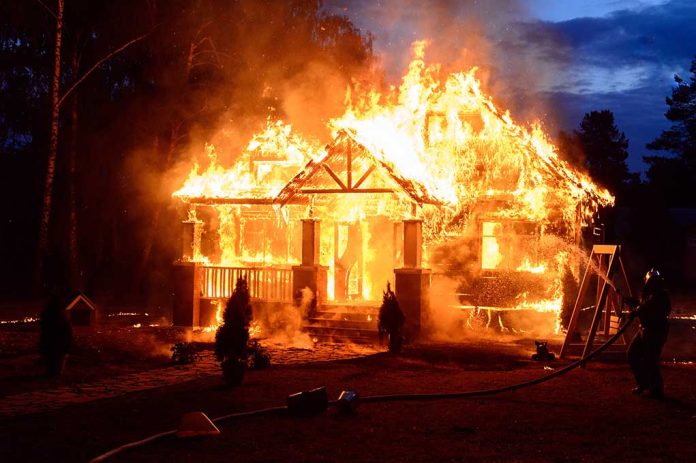
KB Home unveils America’s first wildfire-resistant community in fire-prone Southern California, offering homeowners unprecedented protection against the growing threat of devastating wildfires.
Key Takeaways
- Dixon Trail in Escondido is the nation’s first community to meet Insurance Institute for Business & Home Safety (IBHS) wildfire resilience standards
- The 64-home development incorporates Class A fire-rated roofs, noncombustible gutters, and ember-resistant vents to combat direct flames, radiant heat, and embers
- Homes are strategically positioned over 10 feet apart with 5-foot noncombustible barriers to prevent fire spread
- The community responds to JPMorgan’s alarming prediction of increased wildfire frequency and severity in Southern California
- KB Home’s innovation continues its tradition of pioneering solutions including affordable slab-on-grade homes and all-solar communities
Revolutionary Fire Defense Technology
As California continues to face increasingly devastating wildfire seasons, KB Home has stepped forward with an innovative solution designed to protect life and property. The builder recently unveiled Dixon Trail in Escondido, Southern California — the nation’s first neighborhood explicitly designed with comprehensive fire-resilience features that meet rigorous standards established by the Insurance Institute for Business & Home Safety (IBHS). This pioneering community addresses growing concerns about the escalating wildfire threats that have devastated communities across the western United States.
The 64-home Dixon Trail development incorporates multiple layers of protection against the three primary wildfire threats: direct flame contact, radiant heat, and wind-blown embers. Each home features Class A fire-rated roofs, noncombustible gutters, upgraded windows and doors that can withstand extreme heat, and specially designed vents that prevent embers from entering the structure. These technical specifications represent the cutting edge of fire-resistant construction technology that has been scientifically proven to reduce structure vulnerability.
Strategic Community Layout for Maximum Protection
What distinguishes Dixon Trail from other developments is its comprehensive approach to community-wide protection. KB Home didn’t just focus on individual structures but designed the entire neighborhood with wildfire resilience in mind. Houses are strategically positioned more than 10 feet apart and surrounded by a 5-foot noncombustible barrier zone to minimize fire spread between buildings. This calculated layout serves as a firebreak system throughout the community, effectively creating zones of protection that can contain potential fires.
“In keeping with our tradition of innovation, we are pleased to offer today’s buyers the ability to choose a wildfire-resilient home and community. We are proud that our new Dixon Trail community, with its system of mitigation features, is the first in the nation to meet IBHS’s wildfire resilience standards at the homesite level and at the neighborhood level,” said Jeffrey Mezger, KB Home’s Chairman and CEO.
All-metal fence systems replace traditional wooden fences, eliminating a common fuel source that typically allows fire to spread rapidly through residential areas. Landscaping throughout the development adheres to strict guidelines that minimize combustible vegetation near structures. These community-wide protections work together to create a comprehensive defense system that significantly reduces the likelihood of catastrophic fire spread — a critical advancement in a region increasingly threatened by wildfire danger.
Addressing Escalating Climate Concerns
The timing of Dixon Trail’s development is particularly significant given recent climate predictions for Southern California. KB Home cited a sobering JPMorgan analysis that forecasts increasing frequency and severity of wildfires in the region, with potential economic and insured losses potentially exceeding those from the devastating 2018 Butte County Camp Fire that claimed 85 lives and destroyed thousands of structures. This proactive approach represents a shift from disaster recovery to disaster prevention in residential construction.
“It’s in our DNA at KB Home to keep evolving our homes as solutions for our residents’ and neighbors’ life challenges today and tomorrow,” explained Jacob Atalla, VP of Innovation and Sustainability at KB Home. “We never do this work in isolation. Our role is to connect the dots between science, policy, infrastructure, and construction, and then turn that into something that delivers real value to the families who live in our homes.”
The development is designed to prevent individual house fires “from becoming catastrophic,” according to KB Home’s announcement. When completed, Dixon Trail will receive the first-ever Wildfire Prepared Neighborhood™ designation, highlighting its pioneering status in residential fire protection. This distinction could set a new standard for developments in wildfire-prone regions across the country as more communities seek solutions to protect lives and property from increasingly intense fire seasons.
Setting a New Industry Standard
KB Home’s approach to Dixon Trail represents more than just a single fire-resistant community — it signals a potential paradigm shift in how developers approach construction in wildfire-prone regions. The project demonstrates that resilience, affordability, sustainability, and livability can successfully coexist in modern homebuilding. This balanced approach could serve as a template for future developments as California’s new wildfire zone maps increase regulatory oversight for construction in vulnerable areas.
The company describes the homes as “designed to IBHS’s highest level of protection against direct flame contact, radiant heat and embers, which helps to meaningfully reduce the likelihood of wildfire spread.” This scientific approach to fire protection, developed at the IBHS Research Center in South Carolina, provides homeowners with peace of mind previously unavailable in high-risk fire zones.
KB Home’s Dixon Trail represents a significant advancement in protecting American homeowners from the growing threat of wildfires. By combining innovative construction techniques with strategic community planning, the development offers a blueprint for future fire-resilient communities throughout the country. As climate challenges intensify, this approach to residential construction could save countless lives and billions in property damage while allowing continued development in desirable but fire-prone regions anywhere in the US.






















